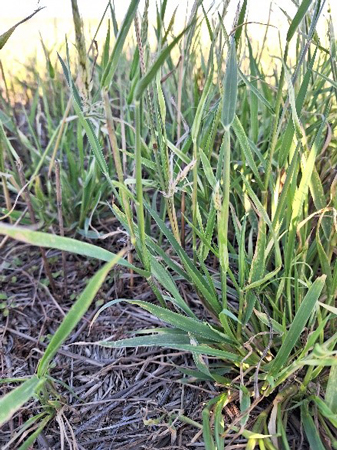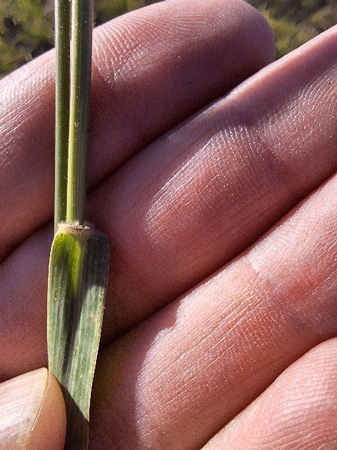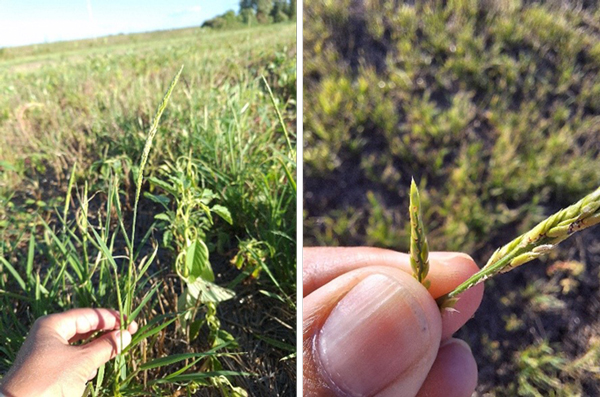K-State Weed Science Extension Specialist, Sarah Lancaster, recently received a call asking to identify a grass that was not controlled by glyphosate. The infestation was prairie cupgrass, which is the topic of this article.
Ecology and Identification
Prairie cupgrass (Eriochloa contracta) is a summer annual grass that prefers moist areas. It is native to the Great Plains and found throughout Kansas in fallow fields and roadsides.
Prairie cupgrass grows in clumps with hollow stems that are generally upright, but can sometimes curve upward (Figure 1) and root where the nodes touch the ground. Stems can grow up to 2 feet tall. Stems may be hairy, especially at the nodes. Leaf sheaths are usually hairy.
Leaf blades are about 1.5 to 8 inches long and fold lengthwise as they dry. There may be short hairs on the leaf and the midrib is not very obvious. The ligule is a fringe of soft hairs, less than 1/25 of an inch (Figure 2).

Figure 1. A clump of prairie cupgrass. Notice the bend in the stem on the left side of the photo. Photo by Sarah Lancaster, K-State Research and Extension.

Figure 2. Short, hairy ligule of prairie cupgrass. Notice the fine hairs on the stem. Photo by Sarah Lancaster, K-State Research and Extension.
Seeds are produced in a slender, dense panicle (Figure 3, left). Individual spikelets are about 1/8 to 1/5 of an inch long and are hairy (Figure 3, right). One seed is contained in each spikelet. Several spikelets are grouped together on a raceme. There are eight to 22 racemes in a panicle
Management
Greenhouse research conducted at K-State during the early 2000s suggests that glyphosate, clethodim (Select Max, others), or quizalofop (Assure II, others) will easily control seedling plants. However, once plants begin to tiller, they are more difficult to control with glyphosate because glyphosate does not move out of the treated leaf. Even at rates up to 1 pound of glyphosate per acre (fl oz) provides about 80% control or less. Products that contain quizalofop will likely provide greater control of mature plants compared to glyphosate or clethodim. In the same paper, weed scientists reported data from field research conducted at Hays that suggest products containing acetochlor or S-metolachlor plus atrazine will provide excellent control of prairie cupgrass season-long.

Figure 3. The infloresence of prairie cupgrass is a compressed panicle (left) made up of several racemes (right) that contain hairy seeds. Photos by Sarah Lancaster, K-State Research and Extension.
The use of trade names is for clarity to readers and does not imply endorsement of a particular product, nor does exclusion imply non-approval. Always consult the herbicide label for the most current use requirements.
Sarah Lancaster, Extension Weed Management Specialist
slancaster@ksu.edu